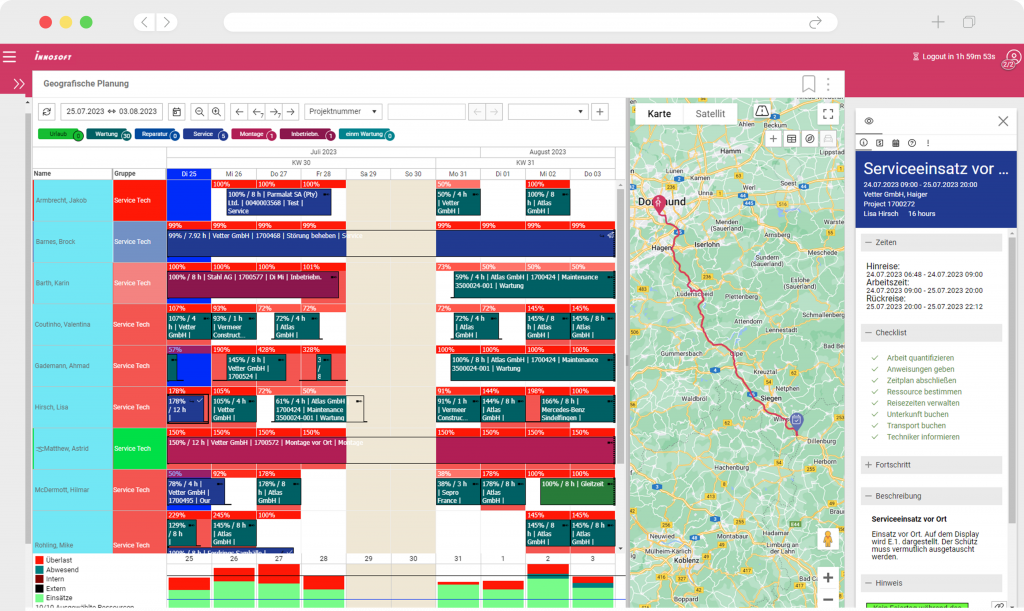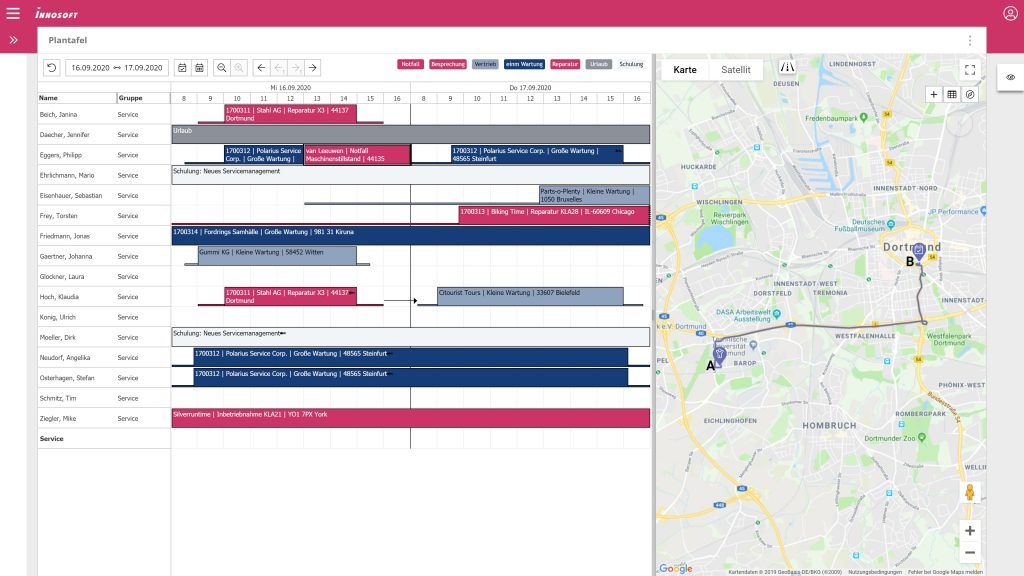Capacity utilization is one of the key factors in professional resource management – especially in field service. It influences how efficiently assignments can be planned, coordinated, and executed. To successfully manage technical field services, you need a clear overview of the utilization of your available resources – from individual technicians to machines or vehicles to the entire service team. Imbalances quickly lead to delays, idle time, or overtime, especially when the utilization limit of individual resources is exceeded. A systematic approach to this issue creates the basis for informed decisions in resource and capacity planning and higher productivity.

Definition: What does utilization mean in resource management?
In resource management, utilization describes the extent to which available capacities are used for specific tasks. In daily resource planning, this means: How much of a technician’s working time is already allocated to orders, and how much time is still available for new assignments? This key figure forms the basis for planning decisions – both for urgent dispatching and for longer-term service assignments. The key factor is the comparison between planned and actual utilization. Continuous monitoring of utilization creates transparency about peak loads, bottlenecks, and free capacities—a key advantage in field service management (FSM), where short-term changes are the order of the day.
How does utilization affect resource allocation?
Precisely recorded utilization enables resources to be deployed in a targeted manner and field service employees to be scheduled efficiently. Finding the right balance is crucial in field service: if the utilization limit is regularly exceeded, the error rate increases significantly.
Conversely, low utilization indicates inefficient resource planning. Regular utilization analysis allows bottlenecks to be identified at an early stage, for example when service orders pile up in certain regions or time periods. At the same time, utilization analysis helps to ensure that teams are evenly loaded and productivity remains at a stable level.
What can be achieved with targeted capacity utilization
Targeted control of capacity utilization in field service helps to deploy technicians economically and avoid unnecessary idle times. This is not just a matter of distributing work, but of creating a sustainable structure over weeks or months – taking into account maintenance intervals, emergency calls, and vacation times.
Clearly defined goals help stabilize deployment processes and measurably improve service quality.
The following points show the specific goals that can be achieved with structured capacity planning:
- Efficient use of existing capacities
- Avoidance of over- and underutilization
- Better planning of deployments and increased operational productivity
- Reduction of idle times
- Long-term relief for employees
- Improved decision-making basis for service managers
Recording utilization: How to control capacities in a targeted manner
Measurable values show whether resources are being used efficiently. A key indicator is the utilization rate. It is calculated from the ratio of hours actually worked to available capacity. For example, if a technician has 40 hours available per week and 32 hours of these are scheduled for service orders, the utilization rate is 80 percent.
In addition to the pure rate, other key figures provide additional guidance:
- Planned vs. actual utilization: This key figure shows the extent to which the planned use of resources corresponds to the actual utilization. Deviations can be analyzed in a targeted manner and taken into account for future planning.
- Utilization per role or team: This evaluates how heavily individual roles or teams are utilized within the company. This helps to avoid overloads and redistribute tasks in a targeted manner.
- Utilization by project or period: This key figure provides information on how resources are used on a project-specific basis or over specific periods of time. It helps you set priorities and allocate capacities realistically.
Such metrics create transparency and form the basis for informed decisions in resource and capacity management. In addition to the quota, it is helpful to define a utilization limit—for example, 90 or 100 percent—at which measures to reduce the load or redistribute resources are initiated.

Optimal utilization in resource management: Finding the right balance
Key figures such as the utilization rate help to visualize resource usage, but on their own they do not provide any information about whether utilization is within a healthy range. This is precisely where the question of the right balance arises: How high can utilization be without leading to overload?
At first glance, consistently high utilization appears productive, but it carries risks such as an increase in errors, a decline in quality, and rising sick leave. On the other hand, values that are too low mean that existing capacities are not being used economically. Optimal utilization therefore lies between idle time and the individually defined utilization limit in order to compensate for peak loads in good time. It takes into account both planned buffer times and short-term fluctuations, thus creating the basis for stable processes and reliable project planning.
Using resources efficiently: strategies for utilization control
Balanced utilization in field service is the result of targeted planning and ongoing adjustment. Service managers and dispatchers are faced with the task of allocating resources in such a way that projects are completed on time and technicians are evenly utilized. Digital tools such as the software solution from Innosoft support this task – from capacity balancing to live monitoring of the deployment situation. The following strategies show how workload can be effectively managed and sustainably optimized in resource management:
- Plan capacities in advance: The basis of any optimization is knowing exactly how many hours are actually available, taking into account vacation, illness, and part-time models. This is the only way to reliably plan resource utilization.
- Assign tasks appropriately: Careful assignment of tasks according to qualifications, location, and availability ensures that working time is used wisely. Free capacity can thus be filled in a targeted manner and idle time avoided.
- Regularly compare planning and reality: By comparing planned and actual utilization, deviations can be identified at an early stage. These findings are incorporated into the fine-tuning process and improve planning reliability.
- Identify bottlenecks early and take targeted countermeasures: Early warnings of impending capacity bottlenecks allow tasks to be redistributed or resource allocation adjusted in good time.
- Use software solutions for support: Digital tools facilitate data collection and clearly display current capacity utilization values. Functions such as dashboards, forecasts, and filters help you quickly grasp complex relationships and make informed decisions.
- Continuously implement optimizations: Utilization should not be viewed statically. Ongoing evaluations and targeted adjustments allow resources to be used more efficiently and the load to be balanced in the long term.
Targeted utilization for stable project processes
Manage your resources efficiently, identify bottlenecks early on, and create planning reliability. With Innosoft, you can keep an eye on your teams’ capacity utilization—for realistic project plans, balanced workloads, higher productivity, and greater transparency in everyday work.
Create planning reliability: Optimize utilization with Innosoft
Efficient utilization management begins with a clear view of available capacities. Innosoft software helps you systematically control resources and make informed decisions based on current utilization data.
By centrally linking project, schedule, and resource data, you can identify areas where action is needed at an early stage—whether individual teams are at risk of becoming overloaded or capacities are being underutilized. The visual representation in the resource plan ensures clarity, even with complex project structures. Filter and evaluation functions also allow you to analyze utilization in detail and make targeted adjustments.
For companies, this means greater transparency, more reliable planning, and better utilization of existing resources. This allows projects to be managed on schedule while keeping an eye on the workload of employees.
Would you like to find out how Innosoft can improve your capacity management? We would be happy to show you how you can significantly increase planning reliability and efficiency.
Contact us for more information on our FSM-Software!
